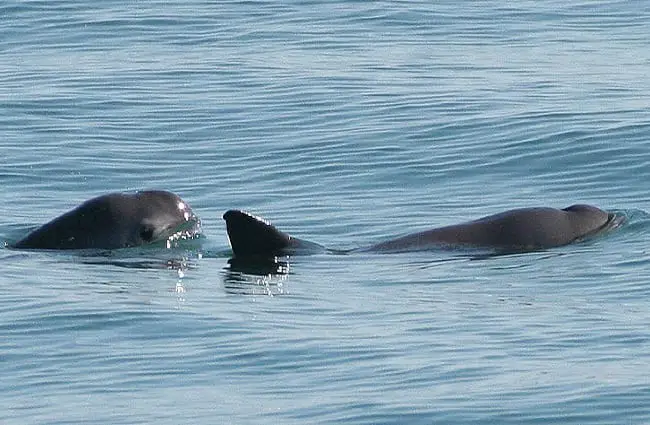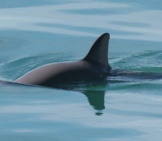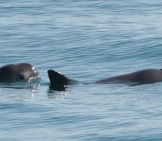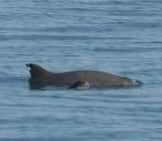The world’s smallest porpoise is also the rarest marine mammal on Earth. This diminutive animal is a critically endangered species of cetacean, a taxonomic clade used to describe whales, dolphins, and porpoises. Read on to learn about the vaquita.
Description of the Vaquita
This comparatively tiny marine mammal is four and a half feet long on average, and only slightly longer than your average golden retriever from nose to tail! These torpedo-shaped marine mammals are dark gray, with a light or white underbelly, and large dark patches around each eye. Vaquitas have a small dorsal fin on their backs, two pectoral fins (one on either side of the body), and a tail fin, also known as a fluke.
Interesting Facts About the Vaquita
This incredibly rare little porpoise has been getting attention in the media due to its precarious population numbers. Relatively little is known about it, simply because individuals are incredibly hard to find to conduct research. Continue reading to learn what little we do know about these mysterious marine mammals.
- What’s in a Name? – The vaquita’s name is reflective of their home range in Mexico’s Gulf of California. In Spanish, vaquita means “little cow.”
- Recent Discovery and Impending Extinction – Vaquitas were discovered fairly recently, with the first individuals officially recorded in 1958. Unfortunately, since the time of their discovery, this animal’s population has dropped an estimated 95%. In 1997, the vaquita population was believed to be 567 individuals, but as of 2017 that number has dropped to just 30 animals.
- VaquitaCPR – An emergency conservation project called VaquitaCPR was launched in 2017. The goal of the group was to capture the remaining individuals and create a captive breeding program to save the species. Unfortunately, the animals did not respond well to the change in environment, and the project was abandoned when a female vaquita passed away. The project has now focused all its efforts on a complete ban of gillnet use in this animal’s habitat.
Habitat of the Vaquita
The vaquita lives and feeds in shallow coastal waters, exclusively in the Gulf of California. They prefer shallow water, as their favorite food sources are bottom-dwelling fish (also known as “benthic”).
Distribution of the Vaquita
The vaquita is restricted to an extremely small range. This unique porpoise is found only in the northern end of the Gulf of California, and nowhere else in the world.
Diet of the Vaquita
Vaquitas eat a variety of fish, squid, crabs, and other crustaceans. Examination of the stomach contents of deceased animals indicates that they have a varied diet. One animal studied was found with 17 different species of fish in its stomach.
Vaquita and Human Interaction
The plight of the vaquita is a bitter one, as populations have been decimated nearly exclusively by fishing for a type of fish called “totoaba.” The totoaba is itself endangered, and totoaba are illegally hunted solely for their swim bladder. This swim bladder is highly valued on the Chinese black market as a form traditional medicine, despite a lack of proof of any actual medicinal value.
The totoaba are captured using gill nets, which are designed to entangle the gills of fish and trap them. Vaquitas get caught in these nets and are unable to return to the surface to breathe. Because vaquitas are mammals, not fish, they drown when trapped under water, and are simply tossed overboard by the fishermen when they bring up the nets. Totoaba fishing has been suspended, but many poachers continue to illegally hunt the fish, and in the process they are killing off the last of the vaquita. It is estimated that there are only 30 left in the world.
Domestication
Vaquita are extremely rare and have not been domesticated.
Does the Vaquita Make a Good Pet
There are simply not enough vaquita left in the world to be kept as pets. They are critically endangered.
Vaquita Care
We know very little of vaquita behaviors and needs. The only attempt to keep them in human care – a last-ditch effort to save the species – failed to keep them alive in sea pens. We know they eat a variety of fish, squid, and crustaceans, but not much else about their needs.
Behavior of the Vaquita
These marine mammals are described as shy, and frequently avoid any contact with boats. Unlike many other species of porpoise, they do not travel in large groups. In the vast majority of sightings, vaquita are spotted alone or in pairs. They do not appear to engage in any above-water acrobatics, as some other species of cetaceans do.
Reproduction of the Vaquita
Very little is known about vaquita reproduction, mainly because of their minimal numbers and secretive behavior. Scientists estimate much of their reproductive information from the harbor porpoise, which is a close relative. It is believed they reach sexual maturity at around 3 to 5 years of age. Gestation is estimated to be about 11 months, and calves likely nurse for up to 8 months.
A Final Word on the Vaquita
Healthy populations rely heavily on genetic diversity. When genetically diverse (not closely related) individuals reproduce, they are less likely to have adverse mutations or infertility. In populations with low genetic diversity, the likelihood of inbreeding increases, and the offspring are less likely to survive and be able to reproduce.
Because the population is so small, scientists believe that the lack of genetic diversity makes it virtually impossible for the species to rebound. Essentially, it is very likely that this shy animal will go extinct. Vaquita populations were decimated in just 20 years. The impact of unregulated overfishing to a single species can be immense, and sometimes the added protections come too late and are ineffective.
Let this animal’s story be a warning to our next generation, and a beacon of hope for future change. Countries have to work together to successfully protect species, and research must be done to determine how to effectively increase population numbers. Hopefully future generations of scientists can continue to improve their methods, and develop innovative ideas for species protection. From cute porpoises, to not-so-cute totoabas, the loss of any species can adversely impact any ecosystem.







![Red Angus Closeup of a beautiful Red Angus cowPhoto by: U.S. Department of Agriculture [pubic domain]https://creativecommons.org/licenses/by/2.0/](https://animals.net/wp-content/uploads/2020/03/Red-Angus-4-238x178.jpg)












![Red Angus Closeup of a beautiful Red Angus cowPhoto by: U.S. Department of Agriculture [pubic domain]https://creativecommons.org/licenses/by/2.0/](https://animals.net/wp-content/uploads/2020/03/Red-Angus-4-100x75.jpg)

